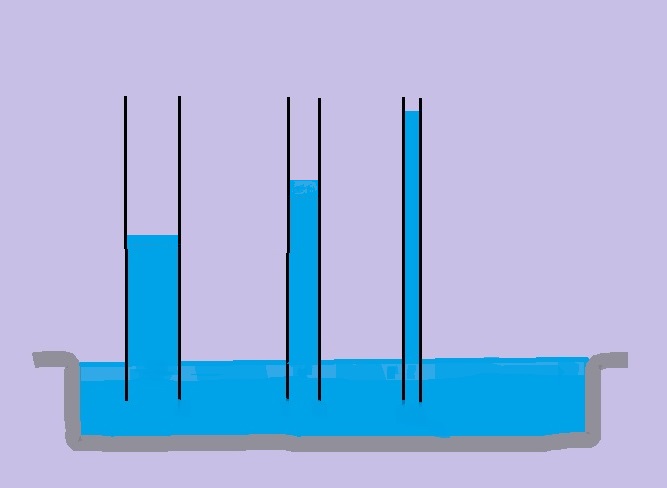Capillary action

|
| Capillary action causes the water in the thinnest tube to rise to a higher level than in the other tubes |
[edit] Introduction
Capillary action is a phenomenon associated with surface tension, whereby liquids can travel – horizontally or vertically (against the force of gravity) in small spaces within materials. It is sometimes referred to as capillary attraction, capillarity or wicking.
The movement is due to the surface tension that results when liquid or moisture is contained within very fine spaces or tubes (capillaries). Essentially, the liquid is attracted to the sides of the container; the smaller the space, the greater the attraction. Examples of capillarity include the action observed when a paper towel or blotting paper absorb water, and the way oil travels up a wick in oil lamps.
[edit] Rising damp
Rising damp in concrete and masonry is also the result of capillary action. When building materials such as most brick types, some stones, concrete blocks and plaster come into contact with moisture, the water adheres to the pores of the material’s capillaries. If the adhesive force between the water molecules and the material is greater than the cohesive force existing between the water molecules themselves, the water rises up the tube through capillary action.
Typically, damp can rise up to around 1m above its source. It is usually prevented from doing so by the installation of a damp-proof course (DPC), typically a polymerised rubber material such as bitumen polymer. Installed as the brickwork goes up and bedded both sides with mortar, the bond between DPC, mortar and walling material creates a barrier to moisture rising through capillary action.
Capillary action is also seen in many plants and trees.
Leonardo da Vinci is regarded as being the first person to observe and record capillary action.
Technical paper 35: Moisture measurement in the historic environment, published by Historic Environment Scotland in 2021, defines capillarity as: ‘The tendency of a liquid in an absorbent material to move as a result of surface tension.’ It suggest that capillary rise is: ‘...controlled by capillarity - the rise of a liquid in an absorbent material above the level that would be influenced solely by atmospheric pressure.’
[edit] Related articles on Designing Buildings
- Blockwork.
- Building damp-free cavity walls.
- Building science.
- Capillary active material.
- Capillary break.
- Chemical injected DPC.
- Damp.
- Damp proof membrane.
- Defects in brickwork
- Defects in stonework.
- Penetrating damp.
- Rising damp.
- Rising damp in walls - diagnosis and treatment (DG 245).
- Tempering heating.
- Vapour barrier.
Featured articles and news
A change to adoptive architecture
Effects of global weather warming on architectural detailing, material choice and human interaction.
How big is the problem and what can we do to mitigate the effects?
Overheating guidance and tools for building designers
A number of cool guides to help with the heat.
The UK's Modern Industrial Strategy: A 10 year plan
Previous consultation criticism, current key elements and general support with some persisting reservations.
Building Safety Regulator reforms
New roles, new staff and a new fast track service pave the way for a single construction regulator.
Architectural Technologist CPDs and Communications
CIAT CPD… and how you can do it!
Cooling centres and cool spaces
Managing extreme heat in cities by directing the public to places for heat stress relief and water sources.
Winter gardens: A brief history and warm variations
Extending the season with glass in different forms and terms.
Restoring Great Yarmouth's Winter Gardens
Transforming one of the least sustainable constructions imaginable.
Construction Skills Mission Board launch sector drive
Newly formed government and industry collaboration set strategy for recruiting an additional 100,000 construction workers a year.
New Architects Code comes into effect in September 2025
ARB Architects Code of Conduct and Practice available with ongoing consultation regarding guidance.
Welsh Skills Body (Medr) launches ambitious plan
The new skills body brings together funding and regulation of tertiary education and research for the devolved nation.
Paul Gandy FCIOB announced as next CIOB President
Former Tilbury Douglas CEO takes helm.
UK Infrastructure: A 10 Year Strategy. In brief with reactions
With the National Infrastructure and Service Transformation Authority (NISTA).
Ebenezer Howard: inventor of the garden city. Book review.
Airtightness Topic Guide BSRIA TG 27/2025
Explaining the basics of airtightness, what it is, why it's important, when it's required and how it's carried out.





















